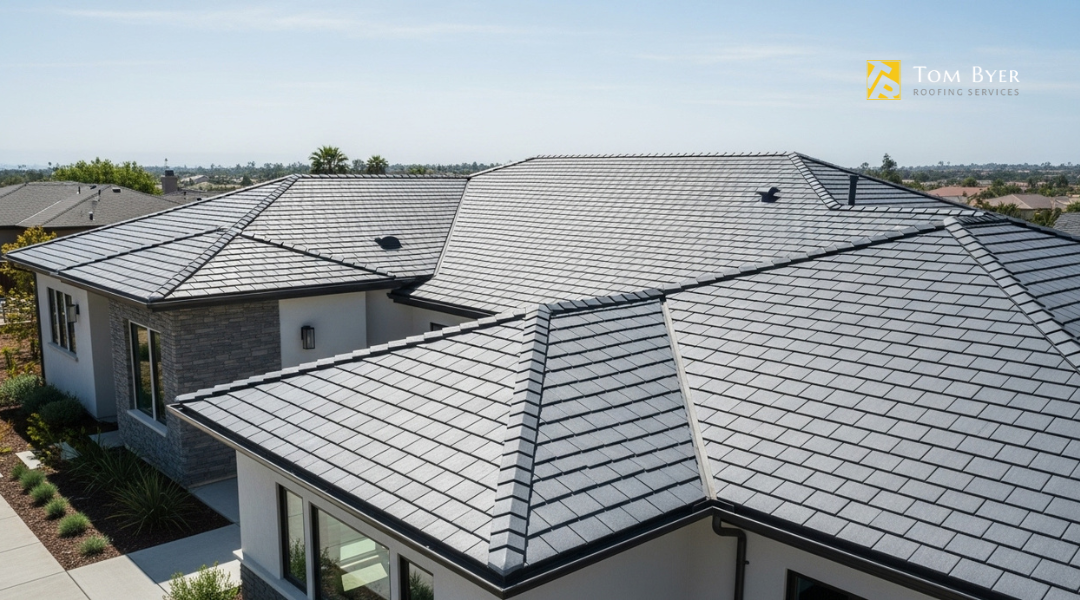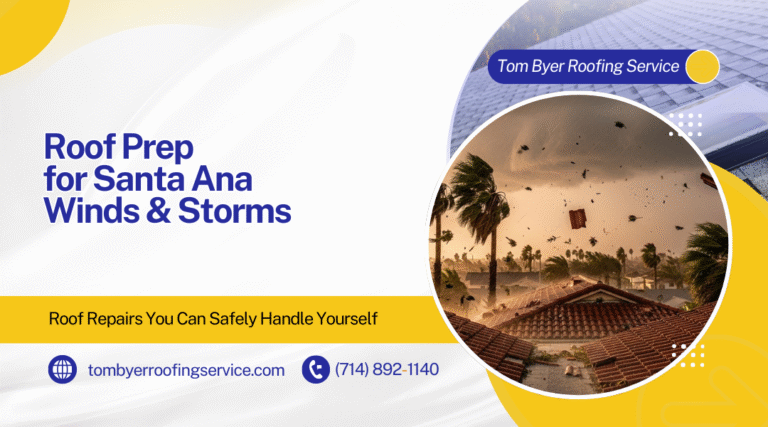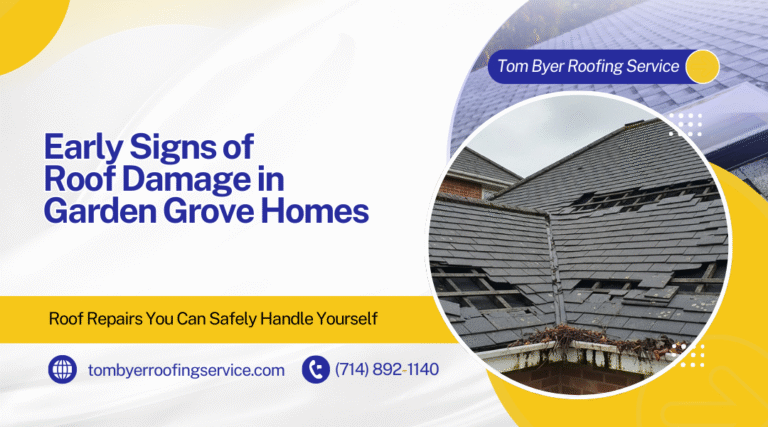Southern California’s unique climate demands roofing materials that can withstand intense sun, occasional rain, and coastal conditions. Tom Byer Roofing Service recommends materials like clay tiles, metal roofing, and synthetic composites for their durability and energy efficiency in this region. These choices balance protection, appearance, and long-term performance for Garden Grove homes.
Homeowners in this area benefit from roofing options designed to reflect heat and resist weathering. Tom Byer Roofing Service combines local knowledge and expertise to guide customers in selecting the best material to fit their needs, budget, and style preferences. This approach ensures roofs that last and maintain property value over time.
Why Climate Matters When Choosing Roofing Materials In Southern California
Southern California’s climate stresses roofs differently than other regions. Materials must withstand intense sun, variable winds, and occasional storms while supporting energy efficiency and proper ventilation.
High Temperatures And Sun Exposure
Roofing materials in Southern California must resist UV damage and heat degradation. Excessive sun can cause certain materials like asphalt shingles to crack or warp over time.
Tile and metal roofs excel in this climate because they reflect heat better and last longer under direct sun. Clay and concrete tiles retain durability but need proper installation to avoid cracking from expansion.
Heat resistance minimizes cooling costs and protects the structural integrity of the home. Selecting materials with high solar reflectance and thermal emittance improves roof longevity and household comfort.
Occasional Storms, Earthquakes, And Santa Ana Winds
Though storms are infrequent, roofing must handle heavy rain and fast winds typical during Santa Ana events. Materials need strong wind resistance ratings to avoid uplift or damage.

Roof types like interlocking tiles and metal panels offer superior holding power in high winds. Earthquake-prone areas like Garden Grove require flexible roofing systems that move without cracking.
Proper fastening techniques, underlayment, and weight considerations also affect durability. Homeowners should prioritize materials tested for local wind speeds of 70+ mph and seismic activity.
Importance Of Energy Efficiency And Ventilation
Energy-efficient roofs reduce cooling loads during long hot seasons. Materials with reflective coatings or light colors help lower surface temperatures effectively.
Ventilation prevents moisture buildup and heat trapping in the attic space. A well-ventilated roof system reduces the risk of mold, wood rot, and premature material failure.
Effective ventilation paired with insulated roofing materials improves indoor air quality and lowers electric bills. It is important to combine radiant barrier technology with ridge vents or soffit vents for optimal air flow.
Key Factors To Consider When Selecting A Roofing Material
Choosing the right roofing material involves balancing performance, cost, and appearance. Homeowners should focus on how long the material will last, its energy-saving qualities, ongoing maintenance, and whether it fits neighborhood rules.
Durability And Lifespan
Durability is critical in Southern California due to exposure to sun, occasional rain, and wind. Materials like concrete tiles and metal roofs are known for lasting 50 years or more. Asphalt shingles typically last 15–30 years but may need replacement sooner.
Resistant to cracking, warping, and fading, tile roofs handle temperature changes well. Metal roofs offer robustness but may dent from hail. Homeowners should consider warranties and local climate when weighing durability.
Energy Efficiency And Heat Reflectivity
Energy efficiency helps reduce cooling costs in hot Southern California climates. Roofs with high solar reflectance, such as light-colored tiles or metal with reflective coatings, lower indoor temperatures.
Materials like clay tiles naturally cool homes by allowing air circulation beneath the tiles. Asphalt shingles have lower reflectivity unless specially treated. Selecting roofing with appropriate reflectivity impacts home energy bills significantly.
Maintenance Requirements
Each roofing material has unique maintenance needs that affect long-term costs. Tile roofs need periodic checks for broken or loose tiles but otherwise require minimal upkeep. Asphalt shingles may need more frequent inspections and cleanings after storms.
Metal roofs resist moss and algae growth but should be inspected for scratches or rust, especially at seams and fasteners. Understanding typical maintenance helps homeowners plan for expenses and avoid premature roof damage.
Aesthetic Appeal And HOA Compliance
Roofing must complement the home’s style and meet Homeowners Association (HOA) standards when applicable. Tile roofs provide a classic Southern California look, favored in many communities. Metal roofs offer modern or rustic aesthetics depending on the finish.
Asphalt shingles come in various colors but may not meet all HOA requirements. Careful selection ensures both curb appeal and neighborhood compliance, avoiding costly redesigns or penalties.
Top Roofing Materials For Southern California Homes
Southern California’s climate calls for roofing materials that offer durability, energy efficiency, and resistance to weather extremes like heat and occasional heavy rain. The most suitable options balance aesthetic appeal with long-term performance and fire resistance.
Clay And Concrete Tile Roofing
Clay and concrete tiles are widely used in Southern California due to their excellent heat resistance and longevity. These tiles help keep homes cool thanks to their natural thermal properties and air circulation beneath the tiles.
They can last 50 years or more when properly maintained. Additionally, these tiles are heavy and require a strong roof structure. Their fire resistance rating is high, making them ideal for fire-prone areas.
Maintenance is generally low, but broken tiles must be replaced promptly to avoid leaks. Their distinct look also suits Spanish and Mediterranean architectural styles common in the region.
Cool Roof Shingles (Reflective Asphalt Shingles)
Cool roof shingles use reflective granules to reduce heat absorption on a home’s roof, lowering cooling costs. These shingles meet ENERGY STAR® requirements and reflect a significant percentage of solar energy.
Asphalt shingles are affordable, widely available, and easier to install compared to tile or metal. However, their lifespan is shorter, typically 20-30 years, and they can suffer damage from prolonged sun exposure.
They come in various colors and styles, allowing homeowners to maintain aesthetic flexibility. Proper ventilation must be combined for best cooling effects and longevity.
Metal Roofing (Aluminum, Steel, Copper)
Metal roofing is durable, lightweight, and offers excellent resistance to heat, wind, and fire. Aluminum and steel are common choices, with steel providing more strength and aluminum offering superior corrosion resistance.
Copper roofs develop a natural patina over time, adding a unique appearance but increasing upfront cost. Metal roofing typically lasts 40-70 years with minimal maintenance.
These roofs perform well in reflecting solar radiant heat, improving energy efficiency. Installation requires professional expertise to avoid issues like noise or thermal expansion.
Slate Roofing (Natural And Synthetic)
Natural slate roofing provides outstanding durability and an elegant look, often lasting over 100 years. It is fire-resistant and performs well in various weather conditions, including the Southern California sun.
Synthetic slate offers a lightweight, lower-cost alternative with easier installation and reduced maintenance. It mimics the appearance of natural slate but generally has a shorter lifespan.
Both options resist fire and insects. However, slate requires a strong roof frame due to its weight, and natural slate can be brittle and expensive to repair.
Wood Shake And Shingle Roofing (With Fire-Resistant Treatments)
Wood shakes and shingles add a rustic aesthetic and natural insulation but require treatment to meet fire safety codes in Southern California. Fire-retardant chemicals improve their resistance to ignition.
These roofs can weather well, lasting 20-30 years if maintained. Untreated wood is prone to rot, insect damage, and is typically not allowed in fire-prone zones.
Routine maintenance includes cleaning debris and inspecting treatments annually. Treated wood offers warmth and charm while balancing safety and local code compliance.
Synthetic Roofing Materials (Composite, Rubber, Polymer-Based)
Synthetic roofing materials combine durability with design versatility and often imitate traditional materials like slate, wood, or tile. They tend to be lighter than natural options and easier to install.

These materials resist cracking, fading, and fire, often carrying Class A fire ratings. Many are engineered for energy efficiency and require minimal maintenance.
Price and lifespan vary, with some lasting 30-50 years. Their flexibility and lower weight make them suitable for retrofits without requiring structural reinforcement.
Comparison Table: Performance Of Each Material In SoCal Climate
Southern California’s climate requires roofing materials that can withstand heat, occasional rain, and strong sun exposure. Factors like durability, cost, energy savings, and upkeep are key when choosing the right material for homes in this area.
Lifespan, Cost, Energy Efficiency, And Maintenance Side-By-Side
| Material | Lifespan | Cost Range | Energy Efficiency | Maintenance Needs |
|---|---|---|---|---|
| Clay Tile | 50–100 years | High ($15–$30/sq ft) | High – Reflects heat | Low – Occasional repairs |
| Asphalt Shingles | 15–30 years | Low ($3–$5/sq ft) | Moderate | Moderate – Replace damaged shingles |
| Metal Roofing | 40–70 years | Moderate ($7–12/sq ft) | High – Reflects sun, often cool roofing | Low – Rust protection recommended |
| Concrete Tile | 50+ years | Moderate to High ($10–$20/sq ft) | Good heat resistance | Low – Occasional cleaning and inspection |
| Wood Shake | 20–40 years | Moderate to High ($6–9/sq ft) | Low to Moderate | High – Frequent sealing and pest control |
Clay and concrete tiles offer the longest lifespan with excellent heat resistance but come at higher costs. Asphalt shingles are most budget-friendly but need more frequent replacement and moderate energy savings.
Metal roofing balances durability and energy efficiency, with minimal maintenance if properly coated. Wood shakes add aesthetic appeal but require the most upkeep and have a shorter lifespan in SoCal’s dry climate.
Environmentally Friendly And Energy-Efficient Roofing Options
Energy efficiency and sustainability play key roles in modern roofing choices for Southern California homes. Options focus on reducing heat absorption, harnessing renewable energy, and using materials that minimize environmental impact.
Benefits Of Cool Roof Technology
Cool roofs reflect more sunlight and absorb less heat than standard roofs. This reduces the temperature inside the home, lowering the need for air conditioning. In Southern California’s hot climate, cool roofs can cut cooling costs by up to 15%.
Materials for cool roofs include light-colored metal, reflective coatings, and special tiles designed to deflect solar radiation. These roofs help combat urban heat island effects and extend the roof’s life by minimizing heat-related damage.
Solar-Ready Roofing Materials
Solar-ready roofs are designed to support photovoltaic panels without major modifications. They often feature reinforced structures and integrated wiring paths to simplify solar system installation.
Common solar-ready materials include standing seam metal roofs and certain composite shingles. These materials offer durability and compatibility with solar mounting systems.
Investing in a solar-ready roof streamlines the addition of solar panels, supporting renewable energy use and reducing household electricity costs in the long term.
Recyclable And Sustainable Roofing Products
Many roofing options now emphasize recyclability and sustainability. Metal roofs, for example, are often made from recycled materials and can be fully recycled at the end of their life.
Other sustainable materials include clay tiles, recycled shingles, and sustainably harvested wood shakes. These products reduce landfill waste and limit resource consumption during manufacturing.
Choosing recyclable or sustainably sourced roofs supports environmental goals while maintaining durability and aesthetic appeal in Southern California homes.
How Tom Byer Roofing Service Helps Homeowners Choose The Right Material
Tom Byer Roofing Service provides detailed guidance to match roofing materials with the unique needs of each home. Their approach balances cost, durability, and style while ensuring compliance with local standards.
Personalized Recommendations Based On Home Type And Budget
Tom Byer Roofing Service evaluates the specific architectural style and age of a home before suggesting roofing options. They consider factors like roof pitch, size, and exposure to the elements to recommend materials that perform best in Southern California’s climate.
Budget is a critical part of the conversation. The team offers options across price points, from cost-effective asphalt shingles to higher-end metal or tile roofing. This ensures homeowners can select a solution that matches financial plans without sacrificing quality or longevity.
Compliance With Local Codes And HOA Regulations
The company stays current with Garden Grove’s building codes and any applicable homeowners association rules. This prevents potential fines or delays during the roofing process.
They carefully review material choices against regulations on fire resistance, weight restrictions, and appearance standards. This guarantees that all installations meet legal requirements and community aesthetics, providing homeowners peace of mind.
Expert Installation And Long-Term Support
Beyond selecting materials, Tom Byer Roofing Service commits to precise installation by experienced professionals. Proper installation maximizes the material’s lifespan and effectiveness against elements.
They also offer ongoing maintenance advice and repair services. This support helps homeowners protect their investment and address any roofing issues promptly over time.




